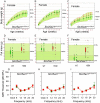Targeting of Slc25a21 is associated with orofacial defects and otitis media due to disrupted expression of a neighbouring gene
- PMID: 24642684
- PMCID: PMC3958370
- DOI: 10.1371/journal.pone.0091807
Targeting of Slc25a21 is associated with orofacial defects and otitis media due to disrupted expression of a neighbouring gene
Abstract
Homozygosity for Slc25a21(tm1a(KOMP)Wtsi) results in mice exhibiting orofacial abnormalities, alterations in carpal and rugae structures, hearing impairment and inflammation in the middle ear. In humans it has been hypothesised that the 2-oxoadipate mitochondrial carrier coded by SLC25A21 may be involved in the disease 2-oxoadipate acidaemia. Unexpectedly, no 2-oxoadipate acidaemia-like symptoms were observed in animals homozygous for Slc25a21(tm1a(KOMP)Wtsi) despite confirmation that this allele reduces Slc25a21 expression by 71.3%. To study the complete knockout, an allelic series was generated using the loxP and FRT sites typical of a Knockout Mouse Project allele. After removal of the critical exon and neomycin selection cassette, Slc25a21 knockout mice homozygous for the Slc25a21(tm1b(KOMP)Wtsi) and Slc25a21(tm1d(KOMP)Wtsi) alleles were phenotypically indistinguishable from wild-type. This led us to explore the genomic environment of Slc25a21 and to discover that expression of Pax9, located 3' of the target gene, was reduced in homozygous Slc25a21(tm1a(KOMP)Wtsi) mice. We hypothesize that the presence of the selection cassette is the cause of the down regulation of Pax9 observed. The phenotypes we observed in homozygous Slc25a21(tm1a(KOMP)Wtsi) mice were broadly consistent with a hypomorphic Pax9 allele with the exception of otitis media and hearing impairment which may be a novel consequence of Pax9 down regulation. We explore the ramifications associated with this particular targeted mutation and emphasise the need to interpret phenotypes taking into consideration all potential underlying genetic mechanisms.
Conflict of interest statement
Figures








References
-
- Mitchell KJ, Pinson KI, Kelly OG, Brennan J, Zupicich J, et al. (2001) Functional analysis of secreted and transmembrane proteins critical to mouse development. Nat Genet 28: 241–249. - PubMed
-
- Meier ID, Bernreuther C, Tilling T, Neidhardt J, Wong YW, et al. (2010) Short DNA sequences inserted for gene targeting can accidentally interfere with off-target gene expression. FASEB J 24: 1714–1724. - PubMed
Publication types
MeSH terms
Substances
Grants and funding
LinkOut - more resources
Full Text Sources
Other Literature Sources
Medical
Molecular Biology Databases

